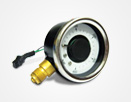Analog Design
Analog hardware design is the art of the mathematically curious who can sustain themselves endlessly in front of an oscilloscope. Through analog design services, we create the finest custom low power as well as high speed analog designs for several tasks like metering, automotive, medical, military and scientific applications. Under our analog design services, the analog system is broken down into various blocks and for each block we work in consideration of the following points:
Sensor Interfacing
This may require pre-amplifying and transporting sensitive signals such as those influenced by thermocouples, ultrasonic transducers, magnetic induction, optical induction, electric fields etc.

- Ultrasonic Signal Detection.
- Challenge: To capture weak, microvolt level ultrasonic signal using discrete opamps, drivers and multiplexers and provide an Auto Gain Control; to ensure a 15 year battery life.
- Scope of Work:
- Master Ultrasonics technology.
- Select low power and low cost OP-Amp, driver and multiplexer.
- Offer good signal to noise ratio.
- Implement automatic gain control over a wide range.
- Engagement: Offsite, 44 weeks.
- Technology: Impedance matching, Low power 2 stage Pre-Amplifier, 2 stage AGC Amplifier, Multiplexer, Driver and Ultrasonic transducers.
- Objectives were accomplished with the design working exceedingly well on low power and low cost parts.
- What is the best way of isolating the sensor considering safety (e.g. Intrinsic Safety), signal preservation and cost?
- Can we use an off-the-shelf IC considering cost and power constraints?
- What are the most optimal cable and connector type considering signal integrity requirements, mechanical strength, ingress protection and cost?
- How do we terminate the signals for minimal reflection?
- What amplifier topology do we use for providing the required gain and filter transfer functions?
- How do we optimally reject large common mode signals while maintain sufficient signal power?
- What is the µA/MHz, GBW, offset, offset drift and other requirements on the preamplifier?
- What is the optimal strategy to minimize thermal noise and yet maintain enough amplifier gain?
- How do we predict and test the thermal drift and noise performance of the amplifier?
- How do we predict drift due to ageing?
Auto Gain Control (AGC)
AGC is quite necessary in applications where signal strength may vary more than a few hundreds of order in amplitude. Light and ultrasonic signal detection are notable examples where an AGC block is indispensable.
- What is the best circuit topology for AGC implementation? What topologies ensure gain control while maintaining a fixed frequency response band?
Analog Filters
These are ubiquitous in analog hardware and indispensable in low power systems where sharp digital filters may impose a power penalty due to time consuming computations.
- What is the minimal Q-factor and transfer function necessary considering the prevalent noise spectral density?
- What is the optimal topology (active filters such as simple Butterworth, Sallen-Key etc. and passive topologies such as T, Pi etc, and combinations thereof) considering the transfer function required?
- What is the significance of group delay for problem in hand and how do we compensate for it?
- What thermal noise would be introduced by the filter itself, and how do we compensate for it?
- Whether inductors are feasible in the design considering their size and cost?
Device Protection blocks
Typically, Device Protection blocks comprises ESD protectors, Thermal switches, R-C Snubbers, MOVs, GDTs, Zeners, TVSes, crowbar structures, overvoltage and overcurrent protection circuits, inrush-current protection circuits and a combination thereof. Ascenten realizes their importance and has immense experience and analytical capabilities in building and testing rugged, reliable analog circuits that outperform the statutory immunity tests and the device’s expected lifetime.
Signal Generation
Signal Generation is the art of generating analog voltage or current signals that resemble the desired waveform as closely as possible under constraints of allowable loading, power and cost. We’re able to design precise signals upto around 300 MHz by deploying a number of phase and frequency locking techniques under the constraints of
- Allowable harmonic distortion
- Allowable overshoots and undershoots
- Allowable frequency drift with temperature and age
- Number of harmonics to be preserved with specified attenuation
Unique techniques
Over the years our engineers have developed a range of subtle tricks to achieve important goals. Some of these are described below:
|
A battery powered circuit was required to work at the full the battery voltage, however a series diode was necessary to prevent a charge reservoir discharging back to the battery. A zero voltage drop diode function was achieved using a combination of analog switches and current sensing techniques. |
|
A battery powered circuit was required to output opto-isolated pulses to an external device which had an internal pull-up. Since opto-isolators are power hungry, they were not feasible. A low cost, low power technique was devised to harness power from the pull-up of the external device and provide power to the local pulse-output block. |
|
An ultra low cost voltage boost function was implemented with only a few passives, using the system microcontroller itself as the boost controller. |
|
A rugged, discrete transistor based amplifier in combination with an op-amp Schmitt trigger was designed to pickup capacitively coupled signals from metal plates attached to car injector cables. These signals can be destructive and reliability requirements were high. |
|
An array of IR LEDs and Phototransistors were used to convert the mechanical movement of a pressure gauge into usable electrical signals. The result was an ultra low cost, mass producible electronic pressure gauge. This gauge is now under mass production. |
Spice simulations
Spice simulation of circuits is necessary when nonlinear elements are introduced. These elements lead to differential equations which are not solvable in closed forms. At Ascenten we use a range of spice tools as well as analog design services. We also study circuits to ensure that they perform as desired under various conditions.









